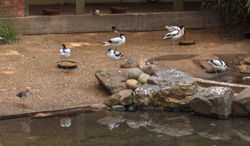Pied Avocet
2007 Schools Wikipedia Selection. Related subjects: Birds
| iPied Avocet | ||||||||||||||
|---|---|---|---|---|---|---|---|---|---|---|---|---|---|---|
 |
||||||||||||||
|
|
||||||||||||||
 Least Concern (LC) |
||||||||||||||
| Scientific classification | ||||||||||||||
|
||||||||||||||
|
|
||||||||||||||
| Recurvirostra avosetta (Linnaeus, 1758) |
The Pied Avocet (Recurvirostra avosetta) is a large wader in the avocet and stilt family, Recurvirostridae.
Adults have white plumage except for a black cap and black patches in the wings and on the back. They have long, upturned bills and long, bluish legs. Juvenile birds are brown where the adult is black, and the juvenile's white plumage is often blotched with greyer patches.
Their breeding habitat is in shallow lakes with brackish water and bare mud exposed. They nest on open ground, often in small groups, sometimes with other waders. 3-5 eggs are laid in a lined scrape or on a mound of vegetation.
They breed in temperate Europe and western and Central Asia. This species is migratory and most winter in Africa or southern Asia. Some remain to winter in the mildest parts of their range, for example in southern Spain and southern England.
These birds forage in shallow brackish water or on mud flats, often sweeping their bills from side to side in water. They mainly eat crustaceans and insects.
The call of the Avocet is a loud klute-klute-klute.
This species gets its English and scientific names from its black cap, as once worn by European advocates or lawyers.
This species became extinct in Great Britain in the mid-19th century. Its successful recolonisation in the 1940s led to its adoption as the logo of the Royal Society for the Protection of Birds.
The Pied Avocet is one of the species to which the Agreement on the Conservation of African-Eurasian Migratory Waterbirds ( AEWA) applies.
